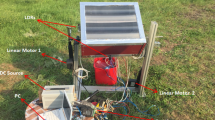Abstract
Due to both reduction and insufficient of fossil fuel to supply current growing energy needs, investigation and employing of renewable resources has been accelerated. Besides, using fossil fuel affected the environment negatively. Therefore, renewable energy resources in the most studies are solar, wind and geothermal. In this study, electrical energy production methods from solar energy have been examined, a fixed and a two axis tracking system have been designed. Both systems are compared each other regarding to several factors by performing annual measurements. Energy consumption of the system is minimized by employing actuator motor in two axis solar tracking system. According to the efficiency of two-axis tracking system, the annual average has been calculated as 31.67% more. This efficiency has been calculated as 70% in winter, 11% in summer. As a result of these measurements several graphics of a year empirically daily, monthly and annual data have been contributed to the literature for Diyarbakir, one of the prominent cities of Southern east, having the most solar energy of Turkey. In the first section, literature review will be indicated. In the second section, solar angles, photovoltaic panels and systems, sample designs and solar tracking systems are examined. In the third section, photovoltaic two-axis solar tracking system and qualifications, work and advantages of fixed system which we designed are stated. In following section, obtained results will be given and in last section, financial analysis of fixed and tracking photovoltaic systems has been performed. Also, recommendations for increasing their efficiency have been noted.
Access this chapter
Tax calculation will be finalised at checkout
Purchases are for personal use only
Similar content being viewed by others
References
Kentli F, Yilmaz M (2015) Mathematical modelling of two-axis photovoltaic system with improved efficiency. Elektron Elektrotech 21:40–43
Yılmaz M (2013) Determination of methods deriving electrical energy from solar energy and optimum efficiency by solar tracking system, PhD thesis, Department of Electrical Education, Marmara University, Istanbul
Yilmaz M, Kentli F (2015) Increasing of electrical energy with solar tracking system at the region which has Turkey’s most solar energy potential. J Clean Energy Technol 3:287–291
Catarius A, Christiner M (2010) Azimuth-altitude dual axis solar tracker, Graduate thesis, W.P.I, Engineering, Massachusetts
Roth P, Georgiev A, Boudinov H (2005) Cheap two axis sun following device. Energy Convers Manag 46:1179–1192
Samimi J, Soleimani EA, Zabihi MS (1997) Optimal sizing of photovoltaic systems in varied climates. Sol Energy 60:97–107
Helwa NH, Bahgat ABG, El Shafee AMR, El Shenawy ET (2000) Maximum collectable solar energy by different solar tracking systems. Energy Source 22:23–34
Akkilic K, Ocak YS, Yilmaz M (2015) Analysing enhancement of electricity generating capacity with solar tracking system of the most sunning region of Turkey. J Clean Energy Technol 3:291–295
Appleyard D (2012) Solar trackers: facing the sun, renewable energy world
Kho CB (2002) Otomatik Kontrol Sistemleri, Yedinci Baskı, Literatür Yayıncılık, İstanbul, pp 207–209
Drury E, Lopez A, Denholm P, Margolis R (2014) Relative performance of tracking versus fixed tilt photovoltaic systems in the USA. Prog Photovolt Res 22:1302–1315
Şenpinar A, Cebeci M (2012) Evaluation of power output for fixed and two-axis tracking PVarrays. Appl Energy 92:677–685
Mecasolar Products Inc. (2014) Mecasolar two-axis 60P, Spain
Huang BJ, Ding WL, Huang YC (2011) Long-term field test of solar PV power generation using one-axis 3-position sun tracker. Sol Energy 85:1935–1944
Salsabila A, Suhaidi S, Mohd ZAAK (2013) Power feasibility of a low power consumption solar tracker. Procedia Environ Sci 17:494–502
Tarabsheh A, Etier I, Nimrat A (2012) Energy yield of tracking PV systems in Jordan. Int J Photoenergy 2012:1–5
Burduhos BG, Visa I, Neagoe M, Badea M (2015) Modeling and optimization of the global solar irradiance collecting efficiency. Int J Green Energy 12:743–755
Lee CY, Chou PC, Chiang CM, Lin CF (2009) Sun tracking systems: a review. Sensors 9:3875–3890
Reisi AR, Moradi MH, Jamas S (2013) Classification and comparison of maximum power point tracking techniques for photovoltaic system: a review. Renew Sust Energy Rev 19:433–443
Mousazadeh H, Keyhani A, Javadi A, Mobli H, Abrinia K, Sharifi A (2009) A review of principle and sun-tracking methods for maximizing solar systems output. Renew Sust Energy Rev 13:1800–1818
Acknowledgements
We would like to thank the Research Council of Scientific Projects Coordinator—Dicle University.
Author information
Authors and Affiliations
Corresponding author
Editor information
Editors and Affiliations
Rights and permissions
Copyright information
© 2017 Springer International Publishing AG
About this chapter
Cite this chapter
Kentli, F., Yilmaz, M. (2017). Improving Tracking Efficiency of Two-Axis Sun Tracking Systems. In: Bizon, N., Mahdavi Tabatabaei, N., Blaabjerg, F., Kurt, E. (eds) Energy Harvesting and Energy Efficiency. Lecture Notes in Energy, vol 37. Springer, Cham. https://doi.org/10.1007/978-3-319-49875-1_7
Download citation
DOI: https://doi.org/10.1007/978-3-319-49875-1_7
Published:
Publisher Name: Springer, Cham
Print ISBN: 978-3-319-49874-4
Online ISBN: 978-3-319-49875-1
eBook Packages: EnergyEnergy (R0)




